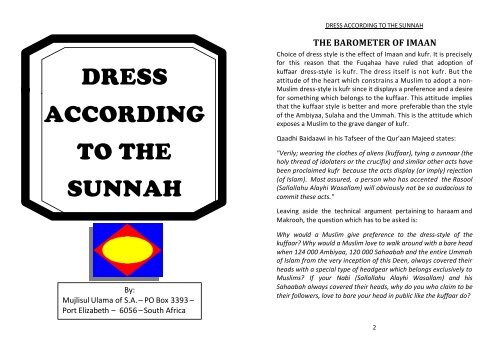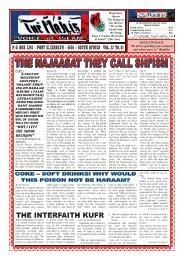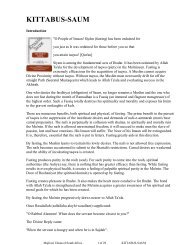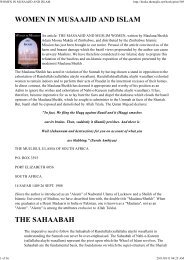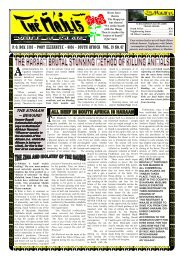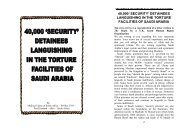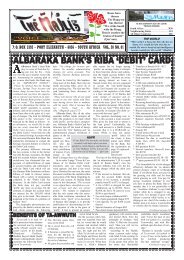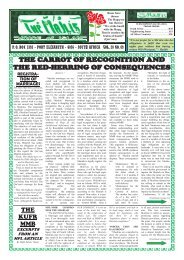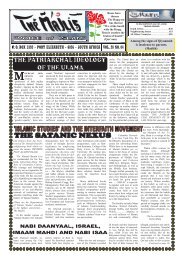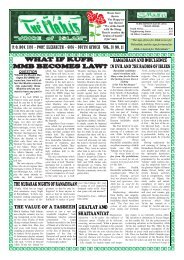DRESS ACCORDING TO THE SUNNAH - The Majlis
DRESS ACCORDING TO THE SUNNAH - The Majlis
DRESS ACCORDING TO THE SUNNAH - The Majlis
- No tags were found...
Create successful ePaper yourself
Turn your PDF publications into a flip-book with our unique Google optimized e-Paper software.
<strong>DRESS</strong> <strong>ACCORDING</strong> <strong>TO</strong> <strong>THE</strong> <strong>SUNNAH</strong><strong>DRESS</strong><strong>ACCORDING</strong><strong>TO</strong> <strong>THE</strong><strong>SUNNAH</strong>By:Mujlisul Ulama of S.A. – PO Box 3393 –Port Elizabeth – 6056 – South Africa<strong>THE</strong> BAROMETER OF IMAANChoice of dress style is the effect of Imaan and kufr. It is preciselyfor this reason that the Fuqahaa have ruled that adoption ofkuffaar dress-style is kufr. <strong>The</strong> dress itself is not kufr. But theattitude of the heart which constrains a Muslim to adopt a non-Muslim dress-style is kufr since it displays a preference and a desirefor something which belongs to the kuffaar. This attitude impliesthat the kuffaar style is better and more preferable than the styleof the Ambiyaa, Sulaha and the Ummah. This is the attitude whichexposes a Muslim to the grave danger of kufr.Qaadhi Baidaawi in his Tafseer of the Qur'aan Majeed states:"Verily; wearing the clothes of aliens (kuffaar), tying a zunnaar (theholy thread of idolaters or the crucifix) and similar other acts havebeen proclaimed kufr because the acts display (or imply) rejection(of Islam). Most assured, a person who has accented the Rasool(Sallallahu Alayhi Wasallam) will obviously not be so audacious tocommit these acts."Leaving aside the technical argument pertaining to haraam andMakrooh, the question which has to be asked is:Why would a Muslim give preference to the dress-style of thekuffaar? Why would a Muslim love to walk around with a bare headwhen 124 000 Ambiyaa, 120 000 Sahaabah and the entire Ummahof Islam from the very inception of this Deen, always covered theirheads with a special type of headgear which belongs exclusively toMuslims? If your Nabi (Sallallahu Alayhi Wasallam) and hisSahaabah always covered their heads, why do you who claim to betheir followers, love to bare your head in public like the kuffaar do?2
A question for meditation is:<strong>DRESS</strong> <strong>ACCORDING</strong> <strong>TO</strong> <strong>THE</strong> <strong>SUNNAH</strong>Whose style is it to wander around bare-headed and whose style isit to cover the head in public?<strong>The</strong> barometer of a man's Imaan is in his dress-style. For some it isa barometer for ascertaining the very validity of Imaan, and forothers a barometer to test the quality of their Imaan. At the least,kuffaar dress-style is fisq.IS KUFFAAR <strong>DRESS</strong>, PART OF <strong>THE</strong> USWAH-E-HASANAH (BEAUTIFULLIFE PATTERN) OF RASULULLAH SALLALLAHU ALAYHI WASALLAM,OR IS ISLAMIC <strong>DRESS</strong> PART OF THIS HOLY LIFE PATTERN?Contents<strong>DRESS</strong> <strong>ACCORDING</strong> <strong>TO</strong> <strong>THE</strong> <strong>SUNNAH</strong><strong>THE</strong> BAROMETER OF IMAAN ................................................................. 1<strong>THE</strong> STYLE OF RASULULLAH'S GARMENT ................................................ 6<strong>THE</strong> TROUSERS ................................................................................. 6<strong>THE</strong> REASON ..................................................................................... 7CATEGORIC PROHIBITION .................................................................. 8<strong>THE</strong> AHADITH ................................................................................... 8COMMENT ..................................................................................... 10<strong>THE</strong> THRUST ................................................................................... 10PRIDE ............................................................................................. 12<strong>THE</strong> HIDDEN DISEASE ...................................................................... 12HADHRAT ABU BAKR ....................................................................... 13IMAAM SHAAFI ............................................................................... 14<strong>THE</strong> ACTUAL POSITION .................................................................... 15<strong>THE</strong> FAC<strong>TO</strong>RS .............................................................................. 15ISLAMIC HEADGEAR ............................................................................ 16NECK TIE – SYMBOL OF SHIRK.............................................................. 24SYMBOL OF SHIRK .............................................................................. 25<strong>DRESS</strong> FOR SALAAT ............................................................................. 2634
<strong>DRESS</strong> <strong>ACCORDING</strong> <strong>TO</strong> <strong>THE</strong> <strong>SUNNAH</strong><strong>DRESS</strong> <strong>ACCORDING</strong> <strong>TO</strong> <strong>THE</strong> <strong>SUNNAH</strong>DIVINE PRESENCE ............................................................................... 27GARMENTS FOR SALAAH ..................................................................... 27IMPORTANCE ..................................................................................... 29BASELESS ARGUMENTS ....................................................................... 30RASULULLAH'S KURTAH ...................................................................... 30ISLAMIC <strong>DRESS</strong> - A SYMBOL OF ISLAM.................................................. 31<strong>THE</strong> STYLE OF RASULULLAH'S GARMENTWhen a modernist Muslim criticizes the dress style and appearance ofRasulullah (sallallahu alayhi wasallam) and the Sahaabah, we in this age inwhich kufr preponderates, are not surprised. Immersed in the kufrconcepts and liberalism of the western kuffaar, it is just natural andlogical for modernists to denigrate every teaching of the Sunnah whichconflicts with the tastes and hues of western culture. In fact, even Ulamahave become so terribly desensitized with the kufr of the modernists as aconsequence of their mutual association and their dubious and baselesspolicies of 'hikmat' and diplomacy, that they (the Ulama) too havebecome chronic victims of the maladies of kufr and liberalism.So while we cannot be surprised when modernists criticize, mock andsneer at the dress styles and appearance of Rasulullah (sallallahu alayhiwasallam) and his Sahaabah, there is not only surprise but shock whenmolvis —products of Darul Ulooms - who purport to be followers of theUlama of the Sunnah, resort to labyrinthal arguments in order to justifystyles which are in conflict with not only the practical example of theNabi, but in diametric opposition to his explicit statements of prohibitionpertaining to certain dress styles.<strong>THE</strong> TROUSERSEvery molvi is aware or should be aware that ALL the Books ofHadith contain many authentic ahadith clearly explaining the style ofRasulullah's izaar. <strong>The</strong>re is absolutely no difference of opinion among anyof the innumerable authorities of the Shariah from the very inception ofIslam that Rasulullah (sallallahu alayhi wasallam) and his Sahaabah alwayswore their izaar and trousers above their ankles.In addition to their practical example, Rasulullah (sallallahu alayhiwasallam) and the Sahaabah verbally propagated in explicit terms theprohibition of wearing the trousers below the ankles. This style iscompletely unrelated to age and time. <strong>The</strong>re was no incumbency of the56
<strong>DRESS</strong> <strong>ACCORDING</strong> <strong>TO</strong> <strong>THE</strong> <strong>SUNNAH</strong>era to wear the trousers in this manner nor were there any physical orgeographic restraints or factors which compelled the adoption of thisstyle. On the contrary, the age and the people of the time demanded thatthe trousers be worn below the ankles in exactly the same way asmodernists, kuffaar and Muslim ashamed of the Sunnah Culture areadvocating today.<strong>THE</strong> REASONIn order to accommodate the liberal fancies of the western kuffaar,molvis in this age of corruption, have hooked onto a legless and baselessargument to justify, propagate and even praise the kaafir style of wearingthe trousers below the ankles—a style which is in clear opposition to thestyle and command of Rasulullah (sallallahu alayhi wasallam).<strong>The</strong> modernist molvis of the liberal cult of westernism are arguing thatthe reason for the prohibition to wear the trousers below the ankles waspride. <strong>The</strong>ir argument goes that on account of pride, the style wasprohibited. But if there is no pride then wearing the trousers below theankles is permissible, in fact commendable by implication of theirbaseless and satanic arguments which they voice over their radiochannels.Why is it haraam for a Muslim to wear a crucifix around his neck or arm?Why should it be haraam for a Muslim to keep a small idol of Bhagwan orBuddha in his pocket or display it in his home. Why should this be haraamif the Muslim concerned has no beliefs of shirk or kufr. He simply regardsthese items as 'artifacts' and symbols of 'history'. He does not believe inthese idols. He does not worship them. But we can claim without fear ofcontradiction that even the modernist molvis have as yet not descendedto the level of corruption which will constrain than to say that keepingsuch idols is permissible if the reason is not shirk/worship. Although thisis still the case presently, we know that there will soon come a time whenkeeping and admiring even these instruments of shirk and kufr will bejustified and made legal by the presentation of the argument that thereason for the initial prohibition was the belief of shirk which had not yetbeen completely eradicated from the hearts of the new converts to Islam.7<strong>DRESS</strong> <strong>ACCORDING</strong> <strong>TO</strong> <strong>THE</strong> <strong>SUNNAH</strong>CATEGORIC PROHIBITIONWhen the Shariah categorically prohibits an act or practice, theprohibition will endure regardless of the reason for which it was initiallyprohibited. Reciting the qira't jahran (aloud) in Zuhr and Asr wasprohibited initially on account of a particular reason which soon after theprohibition no longer existed. But inspite of the disappearance of thereason for the prohibition, the hukm of Sirri (silent) recitation will endureuntil the day of Qiyaamah.Rasulullah (sallallahu alayhi wasallam) said that he who plays chess is likeone who has dipped his fingers in the blood of a swine. Surely there was acogent reason for this stern prohibition. Now, regardless of whether thatreason exists in some cases or not, the prohibition of playing chess willremain until the day of Qiyaamah. In fact, the prohibition has been takenfurther by the Fuqaha (the Authorities of the Shariah). This prohibitionhas been extended to all similar games of the kuffaar.<strong>THE</strong> AHADITHWe shall now present the relevant authentic Ahadith on the issue of thetrousers below and above the ankles and then proceed to further refuteand negate the utterly baseless and devious arguments tendered bymodernists molvis to beguile the Ummah.(1) Abu Hurairah (Radhiyallahu anhu) narrates: Rasulullah (sallallahualayhi wasallam) said: "Whatever of the garment is below the ankles willbe in the Fire (of Jahannum)."(Bukhaari)(2) Ibn Umar (Radhiyallahu anhu) narrates: "Verily the Nabi (sallallahualayhi wasallam) said: Whoever hangs his garment in pride, Allah will notlook at him (with mercy) on the day of Qiyaamah." (Bukhaari and Muslim)(3) Abu Saeed al-Kudri (Radhiyallahu anhu) narrates: "I heardRasulullah (sallallahu alayhi wasallam) saying: <strong>The</strong> izaar of the Mu'min ishalfway on the forelegs (i.e.midway between the knees and the ankles).<strong>The</strong>re is no sin on him in that which is between it and the ankles. And,whatever is below this is in the Fire (of Jahannum). He (Rasulullah8
<strong>DRESS</strong> <strong>ACCORDING</strong> <strong>TO</strong> <strong>THE</strong> <strong>SUNNAH</strong>(sallallahu alayhi wasallam) repeated this statement) three times, and hesaid: Allah will not look (with mercy) at the person who hangs his izaar inpride." (Abu Dawood and Ibn Maajah)(4) Ibn Umar (radhiyallahu anhu) narrates: "I passed by Rasulullah(sallallahu alayhi wasallam) while my trousers was hanging (i.e. below theankles). He then exclaimed: 0 Abdullah! Raise your izaar. I then raised it(a bit). <strong>The</strong>n he (Rasulullah- sallallahu alayhi wasallam) said: Raise itmore! I then raised it more. <strong>The</strong>reafter I was always conscious of it" Somepeople asked: "Until where (did you raise it)?” He (Ibn Umar) said: "Untilmidway of the foreleg.'' (Muslim)(5) Ubaid Bin Khaalid (radhiyallahu anhu) narrates: While I was walkingin Madinah, (I heard) someone behind me say: "Raise your izaar! Verily it(raising the garment) is better for piety and preservation (of thegarment).” I then looked behind and observed that it was Rasulullah(sallallahu alayhi wasallam). I then said: O Rasulullah! It is a simple (ofinferior quality and price) garment. Rasulullah (sallallahu alayhi wasallam)commented: "What, is there not for you in me an example (to follow)?”When I looked (at Rasulullah's garment), his izaar was midway on hisforelegs." (Tirmizi)(6) Salmah Bin Akwa' (radhiyallahu anhu) narrates: "Uthmaan(radhiyallahu anhu) would wear his trousers midway on his forelegs, andhe would say:”So was the izaar of my Companion, i.e. Nabi (sallallahu alayhiwasallam).”(Tirmizi)(7) Huzaifah Bin Yamaan (radhiyallahu anhu) narrates: Rasulullah(sallallahu alayhi wasallam) took hold of the flesh of my foreleg (or of hisforeleg) and said: 'This is the location for the izaar. If you are not satisfied(with this position), then a bit lower. And if you are still not satisfied, thanknow that the izaar has no right in the ankles." (Tirmizi)9<strong>DRESS</strong> <strong>ACCORDING</strong> <strong>TO</strong> <strong>THE</strong> <strong>SUNNAH</strong>Commenting on these Hadith narrations, Hadhrat Shaikh MuhammadZakariyya (rahmatullah alayh) writes:"Severe warnings have been recorded for wearing the lungi, trousers, etc.below the ankles. That section (below the ankles) on which the garmenthangs will be burnt in the Fire (of Jahannum). In view of this type (ofsevere) warnings (of punishment) in the ahadith, special attention shouldbe paid to this matter. But, on the contrary in our age, the garments arespecially (i.e. intentionally) worn below the ankles. To Allah does thecomplainer (register his complaint)."COMMENTInspite of the many unambiguous ahadith explicitly prohibiting thekuffaar style of wearing the trousers below the ankles, molvis in this ageare devoting special time on their radio channels to negate whatRasulullah (sallallahu alayhi wasallam) has commanded.<strong>THE</strong> THRUSTAny level-headed and unbiased Muslim in search of the truth willunderstand after a perusal of the aforementioned ahadith that wearingthe trousers below the ankles is haraam.In Hadith No. 5, Ubaid Bin Khaalid (radhiyallahu anhu) was wearing hisgarment below his ankles. He was walking in the streets of Madinah.When Rasulullah (sallallahu alayhi wasallam) ordered him to raise hisizaar above the ankles. In this Hadith, Rasulullah (sallallahu alayhiwasallam) presented two reasons for wearing the trousers above theankles in this style (of the Sunnah), is greater piety in view of the fact thatit firstly is in conflict with the style of the kuffaar. Secondly, when aMuslim consciously abstains from emulating the style of the kuffaar, herises in rank of taqwa. Following the method of Rasulullah (sallallahualayhi wasallam) is an incumbent requirement of Taqwa, hence he saidthat wearing the trousers above the ankles is ‘ atqaa' (more pious). It thusflows from this reasoning presented by Nabi-e-Kareem (sallallahu alayhiwasallam) that wearing the garment below the ankles is not in conformity10
<strong>DRESS</strong> <strong>ACCORDING</strong> <strong>TO</strong> <strong>THE</strong> <strong>SUNNAH</strong>with taqwa. Whether we understand the relationship between thisstyle and taqwa is of no significance. Since Rasulullah (sallallahu alayhiwasallam) has offered this explanation, it is the fardh duty of everyMu'min to blindly accept it.<strong>The</strong> second argument which Rasulullah (sallallahu alayhi wasallam)presented for his command to wear the garment above the ankles is thatthis style is 'abqaa’ for the garment. In other words the garment will bebetter preserved against the dirt and filth of the road and in this way bebetter protected. <strong>The</strong> Mu'min's trousers should not serve the function ofthe street-sweeper.It is significant that in this Hadith, Rasulullah (sallallahu alayhi wasallam)did not tender the argument of pride. Since he was aware that theSahaabi was not wearing his garment below the ankles on account ofpride, he did not mention pride on this occasion. However, when theSahaabi did not understand the argument, Rasulullah (sallallahu alayhiwasallam) broached the subject from another angle. He asked: "Is myexample and way not sufficient?" In other words, for the Mu'min theacts, practices and example of the Rasool are more than adequate. <strong>The</strong>reis no need to search for reasons and wisdoms for the ahkaam (laws of theDeen). <strong>The</strong> example of Rasulullah (sallallahu alayhi wasallam) iscompulsorily imposed on Muslims by the Qur'aan Majeed. <strong>The</strong>reis no need to look elsewhere and further than this. It thus does notbehove a Muslim, least of all a learned man, to dig out technicalities andby distortion present these in justification of the endeavour to negate thestyle and custom of Rasulullah (sallallahu alayhi wasallam).In Hadith No. 6 Hadhrat Uthmaan (Radhiyallahu anhu), the third Khalifah,long after the demise of Rasulullah (sallallahu alayhi wasallam)commented on the practice of wearing the trousers above the ankles.Everyone knows and accepts that he had no pride. If the order to wearthe trousers above the ankles was based on pride, Hadhrat Uthmaan andall the Sahaabah would not have been so meticulous in observing thisinjunction. <strong>The</strong>y would have worn their trousers below their ankles sincethey were bereft of pride. <strong>The</strong>y had attained the loftiest heights in the11<strong>DRESS</strong> <strong>ACCORDING</strong> <strong>TO</strong> <strong>THE</strong> <strong>SUNNAH</strong>reformation of the nafs. <strong>The</strong>re were no better, no more pious and nohumbler community on earth than the Sahaabah who were thoroughlypurified of all spiritual maladies by Rasulullah (sallallahu alayhi wasallam).Yet, inspite of their high stage of humility, they adhered meticulously tothe style of Rasulullah (sallallahu alayhi wasallam).Everyone who has studied a bit of the history of the Sahaabah, is awarethat Hadhrat Ibn Umar (radhiyallahu anhu) was such a staunch andardent follower of the minutest details of the Sunnah, that peoplebelieved that he would become insane. Pride was never the reason forhim having worn his trousers below his ankles. When Rasulullah(sallallahu alayhi wasallam) saw this, he commanded him to raise hisgarment midway between the knees and the ankles. <strong>The</strong> issue of pridenever featured in his wearing his trousers below his ankles nor in theargument of Rasulullah (sallallahu alayhi wasallam) on the occasion whenhe issued his instruction to this devotee of the Sunnah.PRIDEIn some narrations the reason for wearing the trousers below the anklesis stated as pride. While this was the actual reason in those times for thisprohibited style, it was not always the case with everyone who wouldwear his trousers below his ankles. Hence, we find Rasulullah (sallallahualayhi wasallam) issuing stern warnings and threats of the punishment ofthe Fire for those who wear their trousers in the fashion of the proudpeople. So whether one wears the trousers below the ankles for the sakeof pride or not, one is undoubtedly, imitating the style of the proud onesand the style of the kuffaar. Imitating the kuffaar by itself is a factor ofprohibition.<strong>THE</strong> HIDDEN DISEASENow the question to be asked is: Why would a molvi advocate a stylewhich Rasulullah (sallallahu alayhi wasallam) had prohibited. He did notonly present pride as the reason for the prohibition. So why is there somuch concern to negate a Sunnah style? Leaving aside the technicalquestions and academic rulings, it can be simply understood that the12
<strong>DRESS</strong> <strong>ACCORDING</strong> <strong>TO</strong> <strong>THE</strong> <strong>SUNNAH</strong>permanent practice and style of Rasulullah (sallallahu alayhi wasallam)and his Sahaabah were to wear their garments above the ankles, notbelow their ankles.That wearing the trousers above the ankles is an irrefutable Sunnahpractice will be acknowledged by all Muslims, even the modernists andthe liberal molvis. On the assumption that it is not haraam to wear thetrousers below the ankles, then too, why should Muslims who claim tolove Rasulullah (sallallahu alayhi wasallam) have a desire to scuttle thisSunnah practice and in its place follow the style of the kuffaar? Whosestyle is it to wear the trousers above the ankles? And, whose style is it towear it below the ankles? What does the Imaan of a Mu'min demand,follow the style of Rasulullah (sallallahu alayhi wasallam) or the style ofthe kuffaar? Why is there such a strong aversion in the ranks of theMuslims for the style of Rasulullah (sallallahu alayhi wasallam)?What goes on in the heart of a molvi who advocates a style abhorred byRasulullah (sallallahu alayhi wasallam)? Surely there must be somehidden disease (mardh) lurking somewhere in such a heart. It isinconceivable that a Mu'min of healthy Imaan will ever stoop so low as toscrape the very bottom of the barrel of spiritual corruption. Rememberthat to negate a preference of Rasulullah (sallallahu alayhi wasallam), tofeel ashamed of the style of Rasulullah (sallallahu alayhi wasallam) and topresent devious arguments to distort and deny what Rasulullah(sallallahu alayhi wasallam) had commanded, are worse than consumingliquor, worse than fornication and worse than all the major sins puttogether. Such an attitude is kufr.HADHRAT ABU BAKR<strong>The</strong> solitary narration which the denigrators of Rasulullah's practice areable to produce as 'evidence' is the Hadith in which it is mentionedthat Rasulullah (sallallahu alayhi wasallam) allowed Hadhrat Abu Bakr(radhiyallahu anhu) to wear his garment below his ankles. To present thisHadith in substantiation of the claim, the aim of which is to negate thestyle of Rasulullah (sallallahu alayhi wasallam), is ludicrous and utterlybaseless.13<strong>DRESS</strong> <strong>ACCORDING</strong> <strong>TO</strong> <strong>THE</strong> <strong>SUNNAH</strong><strong>The</strong> Hadith in question is very clear as for the reason of the permissiongranted to Hadhrat Abu Bakr (radhiyallahu anhu) who was highlyperturbed by his inability to maintain his garment above his ankles. Hetherefore, discussed this matter with Nabi-e-Kareem (sallallahu alayhiwasallam). Hadhrat Abu Bakr (Radhiyallahu anhu) was a man with a bigstomach. Inspite of all his efforts to keep his garment in place, he failed.His garment would repeatedly slide down over his ankles. <strong>The</strong> Hadith inquestion explicitly mentions this fact. In view of this condition and hisinability to retain his garment in position above his ankles, he wasexempted from the prohibition. But he had a valid reason. What validreason do the modernists and the liberal molvis have? <strong>The</strong>re are alwaysexceptions to general rules. But the exceptions do not cancel out the lawor the rule. <strong>The</strong> rule remains in place. Furthermore, why do the scoffersof Rasulullah's style cast a blind eye to all the ahadith of prohibition andcling onto this solitary narration which in no way negates the prohibitionstated so emphatically in the other narrations?IMAAM SHAAFILike a drowning man, the modernist molvi tries to cling to every floatingstraw that passes his way. Entirely bereft of proper Shar'i arguments tobolster his corrupt view and enmity for Rasulullah's dress style, the molviclaims that according to Imaam Shaafi (Rahmatullah alayh) it ispermissible to wear the trousers below the ankles.Let us for a moment assume that what the molvi tendered is correct. <strong>The</strong>question now is: Why does the Hanafi molvi resort to a view of ImaamShaafi (Rahmatullah alayh), especially on an issue for which there isabsolutely no need to adopt the view of another Math-hab? If it was acritical issue or an emergency or some urgent need, then in terms of theprinciples of the Hanafi Math-hab, a pious and experienced Mufti willhave the right to issue a Fatwa on the basis of one of the other Mathhabsamong the Four Math-habs. But in this case of wearing the trousers,there is absolutely no such expediency.When a Hanafi molvi ignores the views and fatwas of the authorities ofhis own Math-hab and clings to an opinion of another Math-hab, it14
<strong>DRESS</strong> <strong>ACCORDING</strong> <strong>TO</strong> <strong>THE</strong> <strong>SUNNAH</strong>follows that there is no flexibility for his baseless view in his own Mathhab,hence he had to look elsewhere for aid. His act in itself is sufficienttestimony for the claim that according to the Hanafi Fuqaha and Ulamaand Auliya, wearing the trousers below the ankles is haraam.<strong>THE</strong> ACTUAL POSITION<strong>The</strong> liberal molvi claims that according to Imaam Shaafi (rahmatullahalayh) wearing the trousers below the ankles is permissible. His claimis baseless. Imaam Shaafi does not say that "it is permissible ” . Accordingto the Shaafi Math-hab there are different degrees of prohibition for thestyle of wearing the trousers below the ankles. Explaining this, ImaamNawawi (a Shaafi authority) states in his Sharhul Muslim:"It is not permissible to hang the garment below the ankles if it is forpride. If it is for a reason other than pride it is Makrooh. <strong>The</strong> Mustahabrequirement is midway of the calfs (the forelegs) as it is stated in theHadith of Ibn Umar. Midway of the forelegs is Mustahab. Below this limituntil the ankles is permissible without it being Makrooh. What descendsbelow the ankles is Mamnoo’ (prohibited). If it is for pride, then theprohibition is of the haraam category (i.e. Makrooh Tahrimi). And, if it isnot for pride, the prohibition is of the tanzihi category (i.e. MakroohTanzihi)."Makrooh Tanzihi does not mean 'permissible'. It remains a detestable actin the Shariah. In fact, persistence on a Makrooh Tanzihi act transforms itinto Makrooh Tahrimi which is sinful and a punishable offence. It makes aman a faasiq. Clutching at straws is not Shar'i evidence for a claim.<strong>THE</strong> FAC<strong>TO</strong>RSFrom the aforegoing explanation it will be understood that there areseveral factors for the prohibition of wearing the garment below theankles:(a) It is the style of the kuffaar. Whoever imitates the kuffaar becomes ofthem.15<strong>DRESS</strong> <strong>ACCORDING</strong> <strong>TO</strong> <strong>THE</strong> <strong>SUNNAH</strong>(b) It is the way of the mutakabbireen (proud people). So whetherone has pride or not, is immaterial. <strong>The</strong> fact that the mutakabbireen'sstyle is adopted is in itself a grave sin.(c) <strong>The</strong> opposite style (wearing above the ankles) is 'atqaa' and abqaa'according to Rasulullah (sallallahu alayhi wasallam).(d) Wearing the garment above the ankles is part of the Uswah-e-Hasanah (Beautiful Life Pattern) of Rasulullah (sallallahu alayhi wasallam).<strong>The</strong> Qur'aan commands adoption of this Sunnah.(e) <strong>The</strong> trousers has no haqq (right) on the ankles according to theexplicit pronouncement of Rasulullah (sallallahu alayhi wasallam).(f) What is below the ankles will be in the Fire of Jahannum.In view of all these factors of prohibition, the arguments of the modernistand liberal molvis have absolutely no validity. <strong>The</strong>se molvis should alsounderstand that in airing their liberal, modernist and baatil views, they donot have the support of a single one of our Akaabir Ulama. Our advice isthat they should utilize their radio channels constructively to aid theDeen, not to breakdown Islam and its Culture, for then, there will beabsolute justification for branding their organs of transmission as radioshaitaan and channel shaitaan.ISLAMIC HEADGEARStyle of dress is among the salient features (Sha-aair) of Islam. <strong>The</strong>Shariah accords great prominence to a Muslim's way of dress. Detailedrules enacted by the great rulers of Islam among the Sahaabah, Taabieenand- their followers illustrate the emphasis which Islam lays on the dressof a Mu'min.Among the prohibited factors pertaining to dress is the emulation ofnon-Muslim dress styles. In all ages of Islam such emulation has beenregarded as among the major (kabaair) sins. Tashabbuh bil kuffaar16
<strong>DRESS</strong> <strong>ACCORDING</strong> <strong>TO</strong> <strong>THE</strong> <strong>SUNNAH</strong>(emulating the kuffaar) is an evil with far reaching effect on the heart of aMuslim. Hence, Rasulullah (sallallahu alayhi wasallam) said:"Whoever emulates a people becomes of them."In this article we propose to discuss one particular aspect of Islamicdressing, viz., headgear. In these times of intense ,kufr and dhalaal, whenmany Muslims have sacrificed their intelligence to become slaves ofwestern culture, there is a great desire among modernists to abandonthe wearing of Islamic headgear. Among the styles of Islamic headgear isthe popular topee which innumerable millions of Muslims have donnedover the past centuries of Islamic history. Now in this belated centurymodernists are at pains to discard this compulsory dress-style of Islam.Fallacious arguments are fabricated to deceive innocent and unwarypeople into accepting that the topee or Islamic headgear has norelevance in the Shariah.It should be understood that the ways and styles of Islam did notoriginate from dubious sources nor were its originators non-entities asare the votaries of western styles. Furthermore, Islamic dress-styles wereinherited by the Ummah from generation to generation. Each successivegeneration obtained its Islamic dress-style from its preceding generation.In this way the chain links up with the Sahaabah who disseminatednothing other than the Sunnah of Rasulullah (sallallahu alayhi wasallam).Headgear in Islam is not a new development <strong>The</strong> villifier of the topi mustpresent his proof toindicate the point in time in Islamic history when thisheadgear became an accredited Islamic head-dress. If he contends thatthe topi has no Islamic relevance, let him prove his case with Islamic factsand Shar'i proofs. <strong>The</strong> assertion that many people presently in the MiddleEast pray without headgear is not Shar'i evidence for the fallacy that thetopi has no Islamic status. What is presently being perpetrated in Muslimcountries cannot becited as Islamic evidence for a claim. Only anignoramus who suffers from colossal ignorance will advance such puerileand ludicrous 'proof for hisclaim. When the weight of Islamic practice ofthe past fourteen hundred years upholds Islamic headgear as an integraland incumbent part of a Muslim's chess, then by what stretch of17<strong>DRESS</strong> <strong>ACCORDING</strong> <strong>TO</strong> <strong>THE</strong> <strong>SUNNAH</strong>intelligent reasoning can any Muslim decry and villify such head-dress?When all the illustrious authorities of Islam from the time of the ahaabahemphasised the donning of headgear, not only for Salaat, but at all times,then it is only necessary to dismiss with contempt the arguments againstthe topi blustered out by the enemies of the Sunnah of Rasulullah(sallallahu alayhi wasallam).<strong>The</strong> topi is the head-dress which distinguishes a Muslim from a non-Muslim. <strong>The</strong> importance of this headgear is amply illustrated by thefollowing command of Rasulullah (sallallahu alayhi wasallam):"<strong>The</strong>difference between us and the mushrikeen is turbans on top of qalaanis(topis)."Even mushrikeen were in the habit of donning turbans. Rasulullah(sallallahu alayhi wasallam) detested resemblance with them. Emulatingnon-Muslims is forbidden by Islam, hence Rasulullah (sallallahu alayhiwasallam) ordered that Muslims wear topis under their turbans eventhough the topis are totally concealed and not visible from under theturbans. Even the style of headgear which the Muslim adopts should notresemble the head-dress of the kuffaar, hence Shaikhul Islam Zakariyya(rahmatullah alayh) states:"In our time it is not permissible to wear green and yellow turbans"(Husnus Siyar of Dimyaati Shaafi).Since green and yellow turbans were among the particular dress-styles ofthe Yahood and Nasaara of that time, the authorities of the Shariahbanned the wearing of such turbans so that Muslims do not violate theShar'I prohibition of emulating kuffaar. <strong>The</strong> following verdict appears inFataawa Khaazin and Fataawa Hindiyah:"A man will be proclaimed a kaafir for adopting the head-dress of theMajoos (fire-worshippers)."<strong>The</strong> following verdict appears in the famous Maaliki Kitaab, MukhtasarulKhaleel:18
<strong>DRESS</strong> <strong>ACCORDING</strong> <strong>TO</strong> <strong>THE</strong> <strong>SUNNAH</strong>"A Muslim will be proclaimed a kaafir if h e wears the hat of the Nasaara."Strutting about bare-headed is undoubtedly the style of western manwho has discarded the norms of true civilization. It has never been thestyle of any Muslim community, anywhere in the world, right from thetime of Rasulullah (saliailahu alayhi wasallam) to emerge in public withbare-heads. One who walks around bare-headed is mardoodushshahaadah,i.e. his testimony in an Islamic court is not admissible. ThoseMuslims who are desirous of abandoning the Islamic topi areundoubtedly influenced by western fashions and styles. <strong>The</strong> fact that theyhave opted for a kaafir style at the expense of an Islamic style—a stylewhich the Ummah has always accepted speaks volumes for their way ofthinking. It points to the direction in which their hearts have inclined.Overtly they proclaim them-selves to be Muslims while covertly theirhearts are saturated with love for the styles of kufr. But, Allah Ta'alawarns them:"Do not incline towards the zaalimoon."Inclining towards the kuffaar is banned by Islam in all aspects. A Muslim isnot allowed to unnecessarily adopt the ways, methods, institutions andstyles of the kuffaar. Islam demands head-dress—Islamic head-dress—forits adherents. Western modernity demands a bare-head in order toconfirm to western standards of dress, the westernized Muslimconjectures the most baseless arguments to bolster his case against theways of Islam. This attitude borders on kufr and threaten the Imaan ofsuch deviated modernists. Clarifying the Islamic ban of tashabbuh bilkuffaar, Hadhrat Umar (radhiyallahu anhu) despatched a detailed decreeto the Muslims of Aazarbaijaan (now in Russia). Among the manyprohibitions contained in this Decree the following appears:"<strong>The</strong> dress of your father Ismaa-il (alayhis salaam) is incumbent onyou. Beware of the luxuries and the styles of the Ajam (non Arabs)."Allaamah Ibn Hajar Haithami (rahmatullah alayh), in his Kitaab Azzawaajiran Iqtiraafil Kabaa-ir, records the following narration of MuhaddithMaalik Bin Dinaar (rahmatullah alayh):19<strong>DRESS</strong> <strong>ACCORDING</strong> <strong>TO</strong> <strong>THE</strong> <strong>SUNNAH</strong>"Allah revealed to one of his Nabis: Say to your nation:Do not wear the garments of My enemies for then you will become Myenemies like they are my enemies."In Tafseer Ma-aariful Qur'aan Hadhrat Mufti Muhammad Shafi(rahmatullah alayhi) the then Grand Mufti of Pakistan, explains in theexposition of the aayat:"O! <strong>The</strong> Sons of Aadam! Adopt your beauty at the time ofevery Salaat" (Aayat 31 Surah A'raaf)From this aayat it is obvious that just as the compulsion of concealing thesatr is based on the command in this verse, so too is based thesignificance and merit of donning good and clean garments according toone's means and ability.Since only concealment of the satr is not adequate for Salaat, but theadoption of zeenat (beauty) is also commanded, therefore it will beMakrooh for a man to perform Salaat bare-head, bared shoulders andexposed elbows, whether he has donned short-sleeved shirt or has rolledup his sleeves."Islamic headgear is an integral part of the Sunnah, so much so, that aturban will be described as Islamic only if it is worn ontop of aqalansawah (topi). Abandoning this Sunnah is a sign of Imaani disaster. Itis indicative of the Muslim's drift from Seeraatul Mustaqeem. <strong>The</strong>re canbe no other meaning for a Muslim who detests or regards as insignificantand unimportant the donning of Islamic headgear. While abandonementof any Sunnah invites the Wrath and Curse of Allah Ta'ala, adoption ofthe Sunnah brings in its wake great rewards and creates vitality and Noorin the heart of the Mu'min. In this regard, Rasulullah {saliailahu alayhiwasallam) said:"Whoever protects my Sunnah, Allah honours him with four qualities:He becomes endeared to pious people, evil people fear him,increase in Rizq and steadfastness in Deen. In Al-I’tisaam, Imaam Zuhri20
<strong>DRESS</strong> <strong>ACCORDING</strong> <strong>TO</strong> <strong>THE</strong> <strong>SUNNAH</strong>(rahmatullah alayh) narrates that Imaam Maa-lik (rahmatullah alayh)said:“ <strong>The</strong> Sunnah is like a ship. He who embarks on it is saved whilebe who remains behind (stranded in the ocean) will drown.”Thus, those who have adopted the process of abandoning the Sunnah willsoon find themselves drowning in the raging ocean of kufr, immoralityand baatil. Diversion from the Deen and abandonement of the Sunnah isan incremental process. It commences with the abandonment of theAadaab (etiquettes), progressing to the abandonment of Mustahab acts,then deteriorating to the abandonment of Sunnatul Muakkadah, thenWaajib acts and finally it leads to the neglect of Fardh acts.One's very Imaan is exposed to the gravest dangers by the abandonmentof Sunnat acts. Such abandonment leads to the total distintergration ofTaqwa and Imaan. For this reason it is most dangerous for Muslims toview Islamic headgear as an insignificant item. Nothing in the Deen andSunnah is insignificant. Every act of the Sunnah, be it an Adab or aMustahab act is of great importance for the acquisition of the Pleasure ofAllah Ta'ala. Every Mustahab act being part of Rasulullah's (sallallahualayhi wasallam) Uswah Hasanah (beautiful example)plays a vital role inthe rising stages of Taqwa. Of such importance is Islamic headgear and allother aspects of the Sunnah that the authorities of the Shariah haveruled:"Using a Miswaak is Sunnat, but rejection of thefact that the Miswaak isSunnat, is kufr."<strong>The</strong> Qur'aan Majeed commands Muslims to adopt the Sunnah ofRasulullah (sallallahu alayhi wasallam) and to refrain from every act whichthe Nabi (sallallahu alayhi wasallam} has forbidden:"Whatever the Rasool has given to yon, take hold of it and whatever hehas forbidden you of refrain therefrom." <strong>The</strong> Rasool has given us the wayof dress which includes the Islamic headgear. We are bound by theQur'aanic command to adopt it and uphold it. He has forbidden us fromemulating the kuffaar. Muslims are, therefore, under Qur'aanic obligation21<strong>DRESS</strong> <strong>ACCORDING</strong> <strong>TO</strong> <strong>THE</strong> <strong>SUNNAH</strong>to abhor and refrain from the styles of the kuffaar. <strong>The</strong>re is no gainsayingthat a bare-head is among the styles of the kuffaar. To strut aboutwithout headgear is undoubtedly the way of the kuffaar, especially thelibertine western kuffaar. A Muslim in whose heart is embedded Islamcannot find pleasure in the adoption of a style of the kuffaar. Every kufremulation necessitates abandonment of a Sunnat. Thus, by adopting thekaafir style of walking about bare-headed and entering the Musjid bareheaded,the Sunnah style of Islamic headgear is abandoned.Like kuffaar enter their places of worship bare-headed and like thekuffaar attach no significance to headgear, so too does the westernizedMuslim who follows in the footsteps of the enemies of Allah Ta'ala. Inopposing the Command of Allah Ta'ala, viz. the Sunnah, Muslims areinvoking the chastisement of Allah Ta'ala Who says in the Qur'aanShareef:"Those who oppose His Command should fear a disaster reachingthem or that a painful punishment will overtake them."Spelling out the calamity of confrontation with Rasulullah (sallallahualayhi wasallam), the Qur'aan Majeed says:"Whoever opposes the Rasool after the guidance (of Shariah) has beenmade dear for him and he then follows a path which is not the way ofthe Mu'mineen, then we shall allow him to do as he pleases. And Weshall cast him into Jahannam. Indeed it is an evil place."It is significant and noteworthy that in this aayat, the Qur'aan-e-Hakeemdescribes 'opposition to the Rasool' as being a path other than the pathof the Mu'mineen. Thus, any practice which the Mu'mineen haveinherited from the Salf-e-Saaliheen is in fact the Sunnah. An item of thispractice is the Islamic headgear. Discarding this important item of Islamicdress is in fact a path other than the path of the Mu'mineen. <strong>The</strong> Path ofthe Mu'mineen is given authority and Divine sanction in theaforementioned Qur'aanic Aayat in view of the fact that it stems from theteachings, of the Sahaabah who were the first and the most authoritative22
<strong>DRESS</strong> <strong>ACCORDING</strong> <strong>TO</strong> <strong>THE</strong> <strong>SUNNAH</strong>expounders and upholders of the Sunnah. Diversion from this path of theMu'mineen leads to Jahannum according to the Qur'aan.In the sphere of Islamic belief and practice, the Path of <strong>The</strong> Mu'mineencannot be ignored. <strong>The</strong> Qur'aan Shareef explicitly declares Jahannum tobe the consequence of adopting a path other than the Path of <strong>The</strong>Mu'mineen. While all Muslims who truly believe in Allah, His Rasool andthe Divine Law are Mu'mineen, the uppermost echelons of <strong>The</strong>Mu'mineen are, undoubtedly the Sahaabah, the Taabieen and the Tab-e-Taabieen <strong>The</strong> Mu'mineen of these three noble eras, described byRasulullah ( sallallahu alayhi wasallam) as the Khairul Quroon (the NoblestAges), are undoubtedly the first of the Ummah whom we have toemulate and whose Path the Qur'aan commands us to follow. Islamicheadgear has come to us from these illustrious Mu'mineen whose Pathcan be abandoned only at the peril of Imaan.In the satanic conspiracy to wean Muslims away from the Sunnah andIslam itself, the liberal influences of the western kuffaar are adopted indegrees. In the initial stage of diversion from the Sunnah, the Muslimsimply abandons his Islamic headgear in public, at home and on thestreets. Still believing that such headgear is necessary for only Salaat, itsimportance is diminished for other occasions and as a permanent item ofIslamic dress. Later, when his outlook has changed on account of havingbecome habituated to strut around bare-headed in public and he hasbecome sufficiently audacious by virtue of his Imaani conscience andDeeni convictions becoming paralysed, he rebelliously steps into theMusjid without Islamic Headgear and in this abominable way performshis Salaat without even realizing that he has despoiled the value of hisSalaat. Salaat performed without headgear is Makrooh. Such Salaat hasto be compulsorily repeated within the confines of the time. If it has notbeen repeated within the confines of that particular Salaat, the Fardh (i.e.the obligation) while having been discharged, is short of its rewards andblessings. Such defective discharge of such an important andfundamental institution of Islam will undoubtedly have far reachingconsequences for Muslims in both this transitory world and in theAakhirah.23<strong>DRESS</strong> <strong>ACCORDING</strong> <strong>TO</strong> <strong>THE</strong> <strong>SUNNAH</strong>From the abovementioned discussion it will be clear that dress-style is ofvital importance for the Muslim. It is essential for his spiritualdevelopment that the Muslim differentiates himself from non-Muslims byeven his external appearance. His external appearance must testify thathe is a Muslim. A Muslim dressed in the style of the kuffaar cannot berecognised as a Muslim by another Muslim who is not acquainted withhim. A Muslim in western garb and western appearance can reasonablybe mistaken for a kaafir and he (the imitator of the kuffaar) is solelyresponsible for such a serious mistake committed genuinely. In so far asthe Shariah is concerned, the topi or any Islamic head-dress is essentialfor a Muslim in Salaat as well as at all times. <strong>The</strong> arguments of thedenigrators of the topi arise from kufr mentality and should be dismissedwith contempt.NECK TIE – SYMBOL OF SHIRKIn Pakistan and other Muslim countries there appears no justification tohang on to the western dress in utter disregard of our own gracefulcostumes and derive a false sense of elevation with a rope around ourneck (necktie). <strong>The</strong> necktie is designed by the Christian world as a sign ofthe Cross symbolizing Jesus's crucifixion and thus is an insignia of theChristian faith.Extract from Muslims in Alien Society, by Muhammad Samiullah of PakistanIn the footnotes of this book, the author presents the followinginformation on the necktie:"<strong>The</strong> practice of the necktie started at the insistence of the Pope in 1700.By 1850 all Christian nations had accepted and implemented this order ofthe Pope……..Necktie in reality is a symbol of the cross." (Dr Akhtar Ali,Qaumi Tashakh-khus, pages 5-6)Towards the end of the 19th century the Europeans omitted fromdictionaries and encyclopedias the introductory phase about the necktie,that it is a symbol of the cross....lf one looks at the dictionaries andencyclopaedias printed before 1898 one will find clear indication of the24
<strong>DRESS</strong> <strong>ACCORDING</strong> <strong>TO</strong> <strong>THE</strong> <strong>SUNNAH</strong>cross-symbol relationship in the meaning of the necktie/ (Ehsan QureshiSabri, Daily Nawa-e-Waqat)(<strong>THE</strong> MAJLIS VOL.8 NO.6)(Hadhrat Mufti Muhammad Shafi)SYMBOL OF SHIRKActs which are considered to be signs and salient features of shirk, alsofall within the scope of shirk (polytheism). This is borne out by thecommand of Rasulullah (saliailahu alayhi wasallam) when he saw HadhratAdi Bin Hatim (radhiallahu anhu) with the crucifix around his neck.Hadhrat Adiwho had converted to Islam from Christianity, once came intothe presence of Rasulullah (saliailahu alayhi wasallam) with the crucifixaround his neck. Rasulullah (saliailahu alayhi wasallam) commanded:"Remove this idol from your neck "At this time Hadhrat Adi's belief was already purified. He did not believeany longer in the cross. (<strong>The</strong> wearing of the crucifix was merely by forceof habit). However, Rasulullah (sallallahu alayhi wasallam) ordered itsremoval. He considered it important to command abstention fromdisplaying even the external symbols of shirk. But, alas! Today, thousandsof Muslims are, in defiance and audacity, donning this very symbol of thecrucifix (viz., the necktie), thus making them guilty of the crime of shirk.<strong>THE</strong> MAJLIS VOL 9 NO. 12One may well consider the claim of the tie being a form of the crucifix asbeing ludicrous, but consider the following:"<strong>The</strong> neck tie was designed by the Christian world as a sign of theCross symbolising Jesus's (Eesa AJS.) crucifixion and is an insignia ofthe Christian Faith. <strong>The</strong> practice of the necktie started on the insistenceof the Pope In 1790. By 1850 all Christian nations had accepted andimplemented this order of the Pope". (Extracted from EncyclopaediaBritannica),25<strong>DRESS</strong> <strong>ACCORDING</strong> <strong>TO</strong> <strong>THE</strong> <strong>SUNNAH</strong>Consider also the following discovery: Towards the end of the 19thcentury, the Europeans omitted from dictionaries and Encyclopaedias theIntroductory phrase about the necktie being a symbol of the cross. Aglance of encyclopaedias printed before 1898 will confirm this point (E.Quraishi Sabri).Those with any vestige of Islamic dignity and honour will immediatelyabandon such flagrant displays of shirk. Keep in mind the severereprimand of Nabi (Sallallahu alayhi wasallam) and let our love for himcome to the fore. Those who derive a false sense of elevation and pridefrom aping the dress of the West should consider what fools they are.<strong>The</strong>y are feeling proud about having a rope tied around their necks.Editor.Al-Jamiat (South Africa) Nov 1995. Vol.2 No. 15<strong>The</strong> Qur'aan Majeed says:<strong>DRESS</strong> FOR SALAAT“O Son's of Aadam, adopt your beauty at the time of every Salaat n<strong>The</strong> validity of Salaat requires concealment of the satr (that portion of thebody which has to be compulsorily covered). <strong>The</strong> satr for males is fromthe navel to just over the knees which have to b e concealed. If any part ofthe satr is exposed, the Salaat will not be valid.However, apart from the validity of Salaat, Allah Ta'ala requires morefrom His servants when they stand in His Presence. <strong>The</strong>y have to beproperly, decently and Islamically clad as is clear from the term zeenat(beauty) which appears in the aforegoing Qur'aanic verse. Zeenat doesnot refer to only the Satr. It refers to decent and Islamic dress.Salaat performed in garments which lack Islamic decency is Makrooh(detestable) and should be repeated.26
<strong>DRESS</strong> <strong>ACCORDING</strong> <strong>TO</strong> <strong>THE</strong> <strong>SUNNAH</strong>DIVINE PRESENCEDuring Salaat, the servant stands in the special presence of his Creator,Allah Azza Wa Jal. He is, therefore required to adopt dignity , reverenceand respect He cannot act with an indifferent attitude. He is notallowed to be immodestly and improperly dressed when performingSalaat. When man visits a worldly king or has to be present in a court oflaw presided over by a non-Muslim judge or he has to attend aconference or any other meeting which he regards to be of importance,he adorns himself, he dresses in his best garments to present a properand a decent image of himself. But, some people having more respect forworldly personalities, have no regard for the Musjid and the DivinePresence. <strong>The</strong>y come dressed shabbily i n jeans, T-shirts, tight-fitting pantswhich reveal the form of the satr and of even the satr-e-ghaleezah (i.e. ofthe private Parts). <strong>The</strong>y come into the Musjid for Salaat with kuffaar T-shirts decorated with stupid emblems and slogans in emulation of thekuffaar. In Ruhul Ma'aani it is mentioned:"When Hadhrat Hasan (radhiyallahu anhu)—the grandson of Rasulullah(sallallahu alayhi wasallam)—engaged in Salaat, he would don his bestgarments. It was said to him: "O Son of Rasulullah (sallallahu alayhiwasallam): 'Why do you don your best garments He replied:"Verily Allah is beautiful and He loves beauty. I, therefore adorn myselffor my Rabb. It is He who says (in the Qur'aan) "Adopt your beauty atevery Salaat." I, therefore love to wear my most beautiful garments."GARMENTS FOR SALAAH<strong>The</strong> authoritative Book of the Shariah, Badaaius Sanaa'i states that for thepurposes of Salaat, garments are classified into three categories:(1) Mustahabb (preferable) It is Mustahab to perform Salaat in threegarments: Izaar(trousers),Qamees (kurtah-long shirt) and Ridaa (outershawl). An Amaamah (Turban) or Islamic headgear is also included. Someauthorities say that it is Mustahab to have at least two garments- an27<strong>DRESS</strong> <strong>ACCORDING</strong> <strong>TO</strong> <strong>THE</strong> <strong>SUNNAH</strong>upper and a lower garment since both concealment of the satr andzeenat are achieved.(2) Permissible without any Karaahat (i.e. without it beingabominable in any way): Performance of Salaat in two garments—Qamees and Izaar—is permissible since both concealment of satr andzeenat are achieved. This is also described as Mustahab by some.(3) Makrooh (Repugnant): Performance of Salaat in a single garment,viz., in only a trousers (saraaweel) or izaar (lower cloth covering from thenavel until just above the ankles) is Makrooh even though the Salaat isvalidly discharged. <strong>The</strong> repugnance of performing Salaat in this way is onaccount of the prohibition stated by Rasulullah (sallallahu alayhiwasallam) who prohibited performance of Salaat in a single garment. InBadaaius Sanaa it appears as follows:"Makrooh dressing is that a man performs Salaat in one garment(viz. alower garment) while his shoulders are bare. Although satr-e-aurah isachieved, zeenat is not. Allah Ta'ala says in the Holy Qur'aan: "O BaniAadam adopt your zeenat at (the time of) every Salaat." It is narratedthat someone asked Abdullah Ibn Umar (radhiyallahu anhu) aboutperforming Salaat in a single garment. He responded: If I send you forsome work will you walk in a single garment?" <strong>The</strong> man said: "No!"Abdullah Ibn Umar replied: "Allah is more deserving that you beautifyyourself for Him."Imaam Abu Hanifah (rahmatullah alayh) said: "Verily Salaat in onegarment is the act of unjust (shameless) people. Salaat in detestablegarments is worst than injustice, and Salaat in (two garments izaar andridaa' is among the noble qualities (of character)."(Badaa'i)Mufti Muhammad Shafi says in Ma-aariful Qur'aan: "Since, in Salaat, theonly demand is not only covering of the satr, but the command is toadopt zeenat as well, therefore it is Makrooh (abominable) for a man toperform Salaat with bare-head or with his shoulders exposed or withelbows exposed whether it is a short-sleeved shirt or whether thesleeves are rolled up. In every case the Salaat is Makrooh.28
<strong>DRESS</strong> <strong>ACCORDING</strong> <strong>TO</strong> <strong>THE</strong> <strong>SUNNAH</strong>Similarly (Salaat is Makrooh) if performed with a handkerchief tiedaround the head. An intelligent man will not go in the presence of hisfriends and others in this state. How then can be prefer to go into thepresence of Rabbul Aalameen in this state? <strong>The</strong> Salaat being Makroohwhen performed with bare-head, bared shoulders and uncovered elbows,is substantiated on the basis of the word zeenat mentioned in theQuraanic verse as well as from the explicit statements of Rasulullah(sallallahu alayhi wasallam)IMPORTANCE<strong>The</strong> importance of correct dress for Salaat is stated in HajjatullahilBaalighah by Shah Waliullah Muhaddith Dahlawi (rahmatullah alayh):u Know that wearing of clothes distinguishes man from all animals. It isamong his best conditions.... In dress is the honouring of Salaat andobservance of the respects of supplication with Rabbul Aalameen. It is anoriginal incumbency. It has been decreed a condition for the perfection ofSalaat..."<strong>The</strong> importance of dress for Salaat does not refer to the minimum satrcoverage necessary for the validity of the Salaat. <strong>The</strong> reference is tocorrect dress which is such dress considered Islamically to be respectable.Thus, garments which are not regarded as respectable in Islamic cultureare Makrooh and the Salaat too is rendered Makrooh.Salaat performed with sleeves rolled up or with the elbows exposed isconsidered disrespectful in Islam. It is not regarded as a decent form ofdress. In Ahsanul Fatawa, the following is said in this regard:“It is Makrooh Tahrimi to perform Salaat with sleeves rolled up withoutvalid reason."Ramali has said that Makrooh in this context refers to Makrooh Tahrimiwhich is a sinful act. <strong>The</strong> detestibility of performing Salaat with elbowsexposed is mentioned in a number of Books of Fiqh.29<strong>DRESS</strong> <strong>ACCORDING</strong> <strong>TO</strong> <strong>THE</strong> <strong>SUNNAH</strong>BASELESS ARGUMENTSSome people claim that there is nothing wrong in performing Salaat withsleeves rolled up, with T-shirts, with tight pants and with western shirtsand ties because the Shariah has defined the satr to be only from thenavel to the knees. This is a childish, silly and ridiculous argument. Thosewho present such baseless arguments will not go into public or to courtor to their business places with only loin cloths covering only their satr.<strong>The</strong>y adorn themselves and present a stylish image, adding perfume andlotion and powder, etc. to perfect their appearance. But, for Salaat, whenthey have to stand in the special presence of Allah Ta'ala they are able totolerate hooligan appearances.If the requirement is only to cover the satr, then why on a hot day dothey not come to Musjid with only a piece of cloth covering their satr?Why do they not wander around the streets in this nude fashion withonly their satr covered? <strong>The</strong>y refrain from such semi-nudity because theyknow that they may be rushed to the madhouse.When Rasulullah (sallallahu alayhi wasallam) has prohibited performanceof Salaat in a single garment, it testifies that the requirement for aperfect Salaat is not mere covering of the satr. Dress plays an importantrole in the perfection of Salaat. Salaat performed in the indecent dress ofthe kuffaar is Makrooh and has to be repeated. Defectively dischargedSalaat is flung back into the feces of the musallis.RASULULLAH'S KURTAHHadhrat Umme Salmah (radhiyallahu anhaa) narrates:"<strong>The</strong> most liked dress by Rasulullah (sallallahu alayhi wasallam) was theqamees (kurtah)." (shamaa-il Tirmizi)Qamees is a kurtah (the upper garment-a long shirt). <strong>The</strong> Qameeswhich has the closest resemblance to the qamees of Rasulullah(sallallahu alayhi wasallam) and his Sahaabah is the kurtahadopted by our senior Ulama and Auliya, namely, the Ulama of Deoband.30
<strong>DRESS</strong> <strong>ACCORDING</strong> <strong>TO</strong> <strong>THE</strong> <strong>SUNNAH</strong><strong>The</strong> Qamees of Rasulullah (sallallahu alyahi wasallam) in lengthreached half the forelegs (nisf-e-saaqain)—well below the knees.It never reached the ankles. It is only the qamees (kurtah) of ourUlama which measure up to the dimensions of Rasulullah's(sallallahu alayhi wasallam) kurtah.<strong>The</strong> long shirt worn by modern Arabs nowadays is a decidedlyun-lslamic and Haraam garment. <strong>The</strong> factors of prohibition of themaxi-modern long western imitated shirt are:(1) It is ankle-length and below ankle-length is Haraam(2) Its shirt-like sleeves with cuffs is in emulation of thekuffaar.Similarly, the knee and above knee-length kurtah worn by modernistmolvis is also not permissible.ISLAMIC <strong>DRESS</strong> - A SYMBOL OF ISLAMAllah Ta’ala has divided mankind into two classes:Hizbullaah (the Army of Allah) and Hisbush Shaitaan (the Army ofShaitaan). <strong>The</strong> kuffaar- all of them — are members of the army ofshaitaan. Rasulullah' (sallallahu alayhi wasallam) warned:"Whoever emulates a people becomes of them."Muslims who emulate the ways, styles and dress of the kuffaar shouldunderstand that in so doing, they show a strong preference for the armyof shaitaan. By the styles and appearances of the kuffaar. Muslimsultimately become members of the army of shaitaan.<strong>DRESS</strong> <strong>ACCORDING</strong> <strong>TO</strong> <strong>THE</strong> <strong>SUNNAH</strong>directive to tfae governor of Azarbaijaan which had come under the swayof the Islamic empire, Hadhrat Umar (radhiyallahu anhu) commanded:"Adopt the dress of your Father, Ismaaeel (alayhis salaam), and beware ofluxury. Wear simple, coarse and old garments."Hadhrat Umar bin Abdul Azeez (rahmatullah alayh) known as Umar <strong>The</strong>Second, wrote to his governors:"Ban in your region the wearing or the garments of the Nasaara(Christians)...Be firm and strict in this regard\ Disseminate this order inwritten form so that it does not remain hidden from anyone.It has been mentioned to me that numerous among the Nasaara havereturned to wearing turbans and they have abandoned wearing theirwaist-girdles (which was exclusive to them). <strong>The</strong>y have started to growlong hair (i.e. they had abandoned their Nasaara style andhad begun adopting the hair style of the Muslims who were the rulers). ByAllah! If all this is happening in your region then it is clear evidence ofyour weakness. <strong>The</strong>refore, enforce what I have forbidden. Do not be laxin any of these things, and do not be unjust to anyone."Dress-style is a practice of great importance in Islam. For this reason theKhulafa-e-Raashideen, Hadhrat Umar ) in particular, went to great lengthsto prevent Muslims from adopting the dress-styles of non-Muslims andvice-versa as it is clear, from the directive mentioned above issued byHadhrat Umar Bin Abdul Azeez (rahmatullah alayh).<strong>The</strong> issue of imitating the kuffaar in their dress styles is of suchimportance and off such a grave nature, that Hadhrat Umar (radhiyallahuanhu), during his Khilaafat, issued special instructions to his governors toprohibit tashabbuh bil kuffaar in matters of dress and daily life. In a3132


